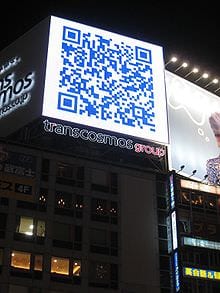QR codes? The Why and How of applying these new tools
As Smart Phones and Smart Phone Apps increase in usage we’re seeing a lot more interest in how to use QR codes (also known as 2D barcodes or mobile tagging) as a part of the marketing mix.
Late last year Nielsen predicted that smart phones will be the dominant device by the end of 2011, so there’s certainly a reason to be taking this area more seriously.
What are QR codes?
Firstly, in case you’re not 100% clear on what QR codes are – QR – ‘Quick Response‘, originally invented in Japan for tracking components in factories.
In short, they offer a method of effectively adding web based content, a URL really, to real-world messages, objects or locations. So they’re great for integrated campaigns to offer a digital offer and drive engagement with a brand, ultimately leading to interactions on a website, social site through the mobile.
The novelty is the way your phone scans and “clicks” to access the content, so they’re inherently tied to smart phone usage. Any user with a smartphone will need to do a one-time download a free application which makes use of the phone’s camera, but other than that you’re away.
Note that there are several variations of code too, so choose a widely adopted one like Jumpscan, EZ code (big in the US) or the original QR Code by Denso in Japan. Different code types require a different reader.
Marketing applications of QR codes
The applications for marketing are quite vast and pretty obvious when you think about it – you can even create your own QR codes easily enough, as explained by this this post last year on Mashable.
So to get started, we suggest asking the right questions as for any campaign rather than jumping onto QR for the sake of it:
- Who are the audience – are they even using smart phones that way, what’s missing that QR codes could add?
- Amongst the many touch-points the consumer has with your brand – which could favour QR codes, why and any obvious quick wins to test that?
- What are your campaign goals – Don’t forget the real functional uses of QR codes, post-purchase or on the product itself – might that be the best place to test?
- What are they going to do at the end of the QR code – shiny technologies don’t mask awful content – please remember to make sure that the page you take the user too works well on a smart phone – obvious, but…!
- How powerful is your offer – Can you provide enough reward for using – something really helpful, valuable or rewarding?
- Is the offer relevant to the audience and related to the service or product your promoting – the example above doesn’t get this right.
Remember to assist users with what to do, QR codes or 2D barcodes are still new enough that people will likely need a little direction as well as a good enough reason to give it a try.
Our top 7 applications for QR codes
There many decent blog posts (just Google “QR code examples”) that illustrate a lot of uses of codes and will give you to food for thought, some are not so creative, but sometimes the simple functional campaigns are most effective – think QR codes on business cards, sorry that’s really mundane!
Here’s a list of the top applications that I feel have the best combination of practicality, cost and impact:
- Maps and signage – “point and find” or “you are here” – this can work well at events, theme parks are large complexes – where someone might need specific guidance to get to something, quickly. You can even create forms of engagement for virtual treasure hunts, or “find your nearest”
- Coupons and special deals – obvious and likely to become the most exploited, allow users to redeem offers in specific locations, ideally with a time limited offer so they act now
- In-store drive to web – when retail experiences can be so bland, imagine bringing content into that space that offers a richer experience (not a hard sell), check out the PUMA case study at the foot of this post for a great example of this one
- How-to advice – Rich advice based content in the form of “How to” video or maybe audio – great for DIY or interior design, even recipes and cooking advice, maybe a bottle of wine at a restaurant
- After sales care – ever struggled to assemble flat packed furniture or wondered where the specific help area is for the product you have, maybe you just want to add to the “new purchase” experience by having a value-add waiting online for that new consumer or use it for activating a guarantee with data capture
- Direct response mechanic on any advertising (press, TV, outdoor media, direct mail or brochures) – do ensure the landing page appreciates where I’ve come from, that’s a wasted opportunity and can be limiting for the user
- E-ticketing – with the ease of creating QR codes, you can issue e-tickets easily enough and have that scanned from your phone to enable access
The common theme here is that QR codes make rich and relevant interactions possible, and they do it, well, quickly! You (the brand) get the opportunity to add value to the consumer or prospective consumer, they’re not only about exploiting the opportunity of a “great offer” that you might want to make Could be worth trailing something soon since the time maybe now for the best combination of novelty factor and consumer awareness as to what they are.
For more information

